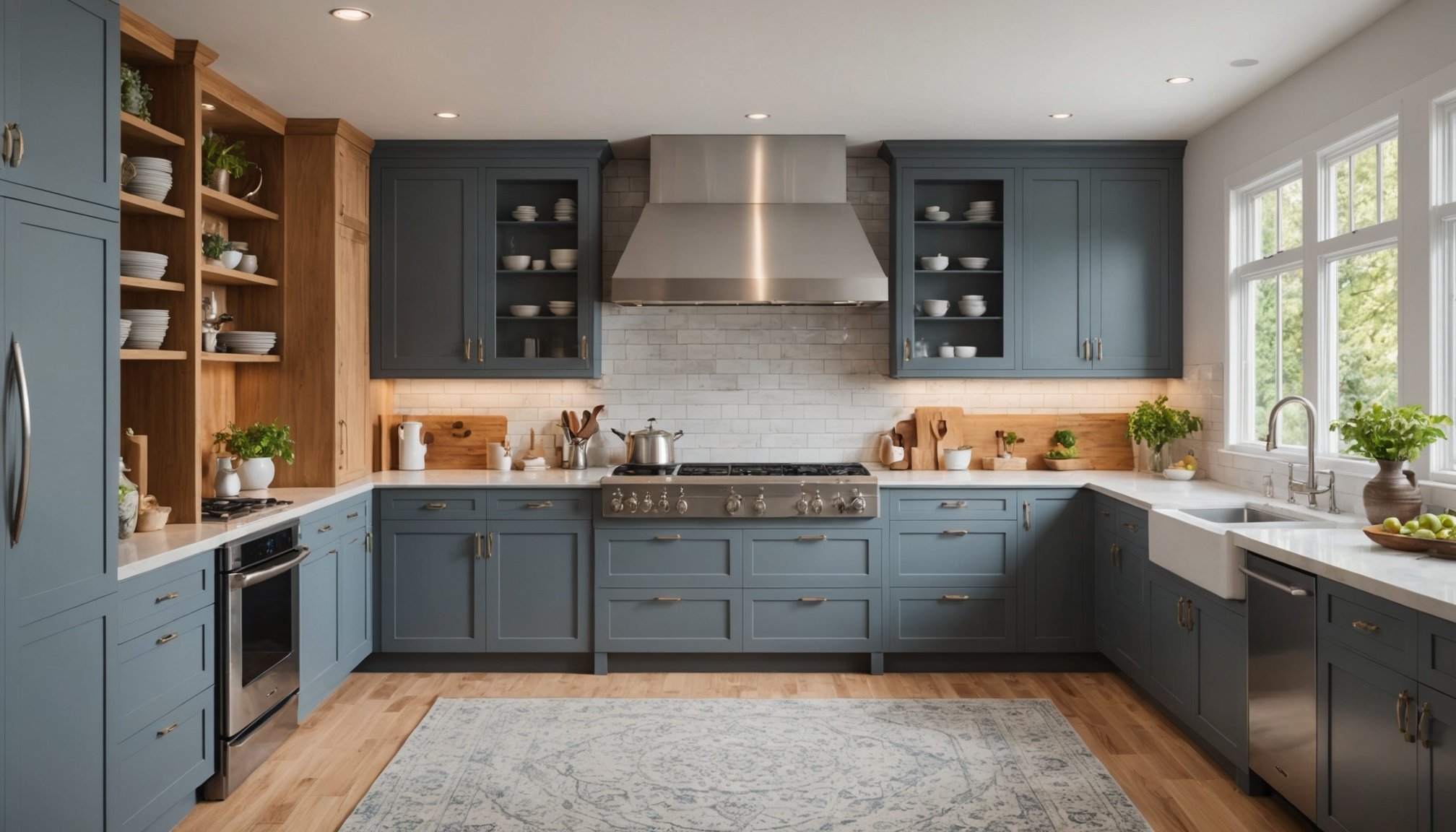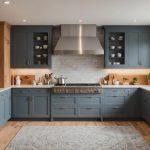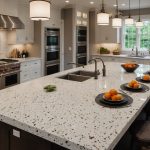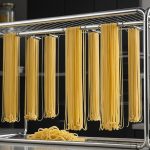Understanding the Importance of a Serenity Kitchen
Creating a peaceful environment in your kitchen can significantly contribute to your mental well-being. The way a kitchen design influences your mood cannot be overstated. A well-designed kitchen allows for a serene ambience, which is particularly beneficial when it comes to daily routines such as meal preparation and dining.
A calming kitchen space helps reduce stress, supports mindfulness, and encourages a sense of tranquility. Colours, textures, and lighting, when thoughtfully selected, can create an atmosphere of calmness and focus. Then, this aesthetic balance can promote relaxation and enhance creativity, facilitating more enjoyable cooking and dining experiences.
Also to discover : Your comprehensive handbook for selecting and maintaining eco-friendly quartz countertops
Furthermore, having a personal space in the kitchen that aligns with your tastes and preferences is essential in supporting mental well-being. It allows you to express your personality and fosters a sense of ownership and comfort, making it easier to recharge after a hectic day.
The importance of such a design can’t be understated, as it sets the stage for a harmonious and enjoyable kitchen experience, balancing functionality with an aesthetically pleasing environment that truly supports your mental wellness.
In the same genre : Unlocking uk building regulations: the ultimate resource for your kitchen makeover journey
Essential Color Schemes for a Calming Kitchen
Creating a serene kitchen through color psychology involves selecting hues that naturally promote tranquility. Certain colors, such as soft blues and greens, are renowned for their soothing effects. Blues evoke a sense of calm and are perfect for spaces meant for relaxation, making them ideal for kitchens seeking serenity. Meanwhile, greens bring a touch of nature indoors, further enhancing a tranquil atmosphere.
For a more dynamic yet still tranquil palette, consider pairing light and dark shades. Combining pale blues with deeper navy can maintain calmness while adding depth and sophistication. Similarly, mint greens mixed with muted forest greens create a lively but soothing visual interest.
Suggested Color Combinations
- Soft blue walls with white cabinetry
- Pale mint with wooden details
- Creamy whites paired with light grey accents
While lighter shades can make the kitchen feel expansive and airy, darker tones add a cozy and inviting vibe. Aim to mix light colors, such as cream or beige, with deeper counterparts like charcoal or navy to balance the kitchen’s ambiance.
Ultimately, the choice of kitchen colors should reflect personal taste while fostering a peaceful environment, turning every cooking experience into a delightful, calming ritual.
Furniture Choices that Enhance Relaxation
Selecting the right kitchen furniture can significantly amplify your comfort and contribute to an overall serene atmosphere. Key elements in achieving this goal include focusing on comfortable and functional furniture. Opt for seating with ample cushioning and consider materials that are both durable and pleasant to touch. This ensures that your kitchen remains a welcoming space, rather than a purely utilitarian one.
Minimalist design plays a fundamental role in fostering tranquility. By focusing on simplicity and clean lines, minimalist furniture removes unnecessary clutter, thus promoting peace and relaxation. The approach centers on choosing furniture pieces that are essential, yet elegantly designed to exude calmness through their subtlety.
When arranging your furniture, consider how the layout affects the flow of your kitchen. Allow for easy movement and unobstructed pathways. Arrangements should allow natural light to flood the space, adding to the ambiance and promoting a feeling of openness. For instance, modular seating can be rearranged to suit different activities while maintaining a harmonious flow.
Balancing comfort with minimalist aesthetics not only enhances relaxation but also optimizes the functionality of your kitchen space—turning it into a serene haven for all activities, be it cooking or socializing.
Layout Considerations for a Calming Experience
Creating an environment that exudes tranquility and relaxation starts with a well-thought-out kitchen layout. The debate between open space and closed kitchen layouts is significant in this scenario. Open kitchens encourage a seamless flow of movement, facilitating interaction and creating an airy feel that can significantly reduce stress during meal preparation. In contrast, closed kitchens provide privacy and can minimize the spread of cooking noises and smells, catering to those who prefer a more contained environment.
When contemplating which kitchen layout best suits your lifestyle, consider zoning your kitchen to enhance both functionality and calmness. Zoning involves dividing the kitchen into distinct areas for different activities such as cooking, cleaning, and socialising, each optimised for ease of use. This thoughtful segmentation ensures that the chaos of multiple tasks doesn’t overwhelm, maintaining a peaceful atmosphere.
Open spaces naturally lend themselves to zoning, as they offer more flexibility in furniture arrangement and decoration. By utilizing clever storage solutions and partitioning methods, even open kitchens can have clearly defined zones without sacrificing their spacious feel. Ultimately, the key to a calming kitchen experience lies in valuing movement, embracing thoughtful design, and choosing the layout that best aligns with your personal and space needs.
The Role of Lighting in Creating a Sanctuary
Lighting is crucial in transforming a kitchen into a true sanctuary. Natural light stands out as a key component in kitchen design. It not only illuminates the space but also enhances well-being and mood. Maximizing natural light involves strategic placement of windows or skylights. This encourages a serene atmosphere that resonates throughout the kitchen.
When natural light is limited, ambient light becomes essential. Ambient light should mimic the qualities of natural light, providing a soft and consistent glow. This can be achieved through ceiling fixtures, wall sconces, or under-cabinet lighting. Ambient lighting offers a comforting and tranquil environment, perfect for any kitchen sanctuary.
Layering lighting plays a pivotal role in enhancing both versatility and mood. To achieve this, consider combining ambient light with task and accent lighting. Task lighting, like pendant lights, targets specific areas such as countertops or islands, ensuring functionality. Accent lighting, such as LED strips, highlights design features or artwork, adding personality and warmth.
When carefully arranged, kitchen lighting not only meets practical needs but also creates an inviting ambiance. By integrating natural light with layered artificial light, the kitchen becomes a personalized haven of tranquility and style.
Material Choices that Promote Peacefulness
In the pursuit of a tranquil kitchen oasis, selecting materials with soothing textures and incorporating natural elements can have a profound impact. Natural elements, like wood and stone, often provide a visually calming effect, harmonizing with their surroundings in a way that synthetic materials might not. Utilizing soothing textures, such as matte finishes or soft-touch surfaces, contributes to an environment that is both inviting and serene.
When it comes to kitchen materials, it’s crucial to balance aesthetics with durability. While materials like bamboo or reclaimed wood offer a soothing, organic appeal, they must also withstand the rigours of daily kitchen use. Options like butcher block countertops or ceramic tiles echo the beauty of natural elements while ensuring resilience.
Incorporating plants or natural fibres, such as woven rugs or linen blinds, can further enhance the connection to nature. This strategy not only adds aesthetic value but also promotes a sense of peace and well-being in the space.
By thoughtfully integrating kitchen materials that emphasize soothing qualities alongside natural elements, one can craft a kitchen that serves as both a functional workspace and a peaceful haven.
Decorative Elements that Add Serenity
Creating a tranquil atmosphere in your kitchen can significantly enhance your cooking and dining experience. One effective approach is incorporating calming decor. This type of design focuses on elements that bring peace and relaxation, transforming a functional space into a personal haven.
Personal touches in kitchen decor play a crucial role in achieving this serene environment. By integrating items that resonate with you personally, the kitchen becomes more than just a room; it becomes a reflection of your personality. Incorporate items like family heirlooms or vacation mementos, which can evoke feelings of calmness and nostalgia.
To foster this relaxation further, consider introducing plants and art. Plants are not only a beautiful addition but also improve air quality, contributing to a healthier atmosphere. Select low-maintenance plants such as succulents or herbs that thrive indoors.
Art can act as a soothing influence as well. Choose pieces that evoke positive emotions or reflect landscapes that remind you of peaceful places.
Finally, don’t forget the importance of colour palettes. Soft pastels or earthy tones can create an ambiance conducive to relaxation. These hues work harmoniously with natural light, helping to create a warm and welcoming environment.
Expert Insights and Case Studies
Kitchen renovation can be an overwhelming task, but seeking expert advice can provide invaluable guidance. Interviews with seasoned kitchen design experts reveal crucial insights into successful transformations. They highlight the importance of planning and understanding one’s lifestyle needs. Experts recommend focusing on functionality, as this can greatly affect mental well-being.
Design case studies unveil inspiring stories of kitchen makeovers that prioritize both functionality and aesthetics. An illuminating study details how integrating natural light and open spaces can improve mental health. A well-known designer shared a project where spatial efficiency was maximized by intelligent cabinetry solutions, proving that thoughtful design does not have to compromise beauty.
Key takeaways from these experiences emphasize the need for a clear vision and patience. One should always prioritize personal comfort and practicality during a renovation. Consulting an expert in synergizing utility and charm can lead to remarkable results. Lessons learned underscore the value of meticulous planning and flexibility.
Investing in a kitchen that aligns with your lifestyle demands will not only enhance the joy of cooking but also foster a space that nurtures well-being.











